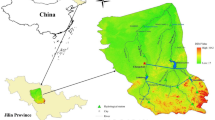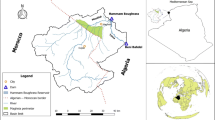Abstract
The objective of this paper is to present an optimal model to address the water resources utilization of the Tao River basin in China. The Tao River water diversion project has been proposed to alleviate the problem of water shortages in Gansu Province in China. A multi reservoir system is under consideration with multiple objectives including water diversion, ecological water demand, irrigation, hydropower generation, industrial requirements, and domestic uses in the Tao River basin. A multi-objective model for the minimization of water shortages and the maximization of hydro-power production is proposed to manage the utilization of Tao River water resources. An adjustable PSO-GA (particle swarm optimization – genetic algorithm) hybrid algorithm is proposed that combines the strengths of PSO and GA to balance natural selection and good knowledge sharing to enable a robust and efficient search of the solution space. Two driving parameters are used in the adjustable hybrid model to optimize the performance of the PSO-GA hybrid algorithm by assigning a preference to either PSO or GA. The results show that the proposed hybrid algorithm can simultaneously obtain a promising solution and speed up the convergence.







Similar content being viewed by others
Abbreviations
- c 1 c 2 :
-
Learning rates in the PSO algorithm
- FS :
-
Frequency of water supply success
- gbest :
-
Global best solution achieved by the swarm
- gbest(GA):
-
Global best solution achieved by the swarm after GA operation
- H (i,t):
-
Effective average turbine head in period t (m)
- k 1 :
-
Influence term for PSO that determines how many individuals in the population can move on to the next generation
- k 2 :
-
Influence term (k 1+k 2=1) for GA that determines how many individuals are replaced in the current generation
- k i :
-
Net efficiency of hydropower station i
- k t j :
-
Position vector of particle j in the tth reproduction step of the PSO algorithm
- N(i,t):
-
Output of reservoir i during period t (kW)
- pbest j :
-
The best solution reached by particle j
- pbest j (GA):
-
The best solution reached by particle j after GA operation
- QC (i,t):
-
Water released through the turbines of hydropower station i in period t (m3/s)
- QG(i t):
-
Water supply of reservoir i in period t (m3/s)
- QI(i t):
-
Inflow of reservoir i during the average period t (m3/s)
- QO(i,t):
-
Release of reservoir i during the average period t (m3/s)
- QP(i t):
-
Water demand of reservoir i in period t (m3/s)
- rand 1 rand 2 :
-
Independent uniformly distributed random variables
- θ(t):
-
Coefficient at time t
- V(i,t):
-
Storage of reservoir i at the beginning of period t (m)
- V(i,t+1):
-
Storage of reservoir i at the end of period t (m3)
- v t j :
-
Speed vector of particle j in the t th reproduction step of the PSO algorithm
- w 1,w 2 :
-
Weighting coefficients set to 0.8 and 0.2, respectively
- W :
-
Inertial weight in the PSO algorithm
- WL(i t):
-
Water loss of reservoir i in period t (m3)
References
Abd-El-Wahed WF, Mousa AA, El-Shorbagy MA (2011) Integrating particle swarm optimization with genetic algorithms for solving nonlinear optimization problems. J Comput Appl Math 235:1446–1453
Chang NB, Wen CG, Chen YL, Yong YC (1996) A grey fuzzy multiobjective programming approach for the optimal planning of reservoir watershed. Part A. Theoretical development. Water Res 30:2329–2334
Dandy GC, Engelhardt MO (2006) Multi-objective trade-offs between cost and reliability in the replacement of water mains. J Water Resour Plan Manage 132(2):79–88. doi:10.1061/(ASCE)0733-9496(2006)132:2(79)
Eberhart RC, Shi Y (1998) Comparison between genetic algorithms and particle swarm optimization. Evolutionary programming VII. Lect Notes Comput Sci 1447:611–6
Fi-John C, Li C, Li-Chiu C (2005) Optimizing the reservoir operating rule curves by genetic algorithms. Hydrol Process 19:2277–2289
Ganji A, Karamouz M, Khalili D (2007a) Development of stochastic Nash Game model for reservoir operation II. The value of players information availability and cooperative behaviors. Adv Water Resour 30(3):157–168. doi:10.1016/j.advwatres.2006.03.008
Ganji A, Khalili D, Karamouz M (2007b) Development of stochastic Nash Game model for reservoir operation I. The symmetric stochastic model with perfect information. Adv Water Resour 30(1):528–542. doi:10.1016/j.advwatres.2006.04.004
Goldberg DE (1989) Genetic algorithms in search, optimization and machine learning. Addison-Wesley, Reading
Grygier TC, Stedinger JR (1985) Algorithms for optimizing hydropower system operation. Water Resour Res 21(1):1–10
Hejazi MI, Cai X (2011) Building more realistic reservoir optimization models using data mining – a case study of Shelbyville reservoir. Adv Water Resour 34:701–717. doi:10.1016/j.advwatres.2011.03.001
Hejazi MI, Cai X, Borah D (2008) Calibrating a watershed simulation model involving human interference – an application of multi-objective genetic algorithms. J Hydroinform 10(1):97–111
Huang WC, Yuan LC (2004) A drought early warning system on real-time multireservoir operations. Water Resour Res 40:W06401. doi:10.1029/2003WR002910
Jian-Xia C, Qiang H, Yi-min W (2005) Genetic algorithms for optimal reservoir dispatching. Water Resour Manag 24:321–331. doi:10.1007/s11269-005-3018-5
Karamouz M, Vasiliadis H (1992) A Bayesian stochastic optimization of reservoir operation using uncertain forecast. Water Resour Res 28(5):1221–1232
Kennedy J, Eberhart R (1995) Particle swarm optimization. Proc. IEEE Int. Conf. Neural Networks, Perth, Australia, Dec: 1942–1948
Kucukmehmetogl M (2009) A game theoretic approach to assess the impacts of major investments on transboundary water resources: the case of the Euphrates and Tigris. Water Resour Manag 23(15):3069–3099. doi:10.1007/s11269-009-9424-3
Kuo-Wei W, Li-Chiu C, Fi-John C (2011) Multi-tier interactive genetic algorithms for the optimization of long-term reservoir operation. Adv Water Resour 34:1343–1351. doi:10.1016/j.advwatres.2011.07.004
Labadie JW (2004) Optimal operation of multi-reservoir systems: state-of the-art review. J Water Resour Plan Manage, ASCE 130(2):93–111
Mousavi SJ, Karamouz M, Menhaj MB (2004) Fuzzy-state stochastic dynamic programming for reservoir operation. J Water Resour Plan Manag, ASCE 130(6):460–70. doi:10.1061/(ASCE)0733-9496(2004)130:6(460)
Oliveira R, Loucks DP (1997a) Operating rules for multi-reservoir systems. Water Resour Res 33(4):839–852
Oliveira R, Loucks DP (1997b) Operating rules for multi-reservoir systems. Water Resour Res 33(4):839–851
Pereira MVF, Pinto LMVG (1985) Stochastic optimization of a multi-reservoir hydroelectric system: a decomposition approach. Water Resour Res 21(6):779–792
Rani D, Moreira MM (2010) Simulation-optimization modeling: a survey and potential application in reservoir systems operation. Water Resour Manag 24:1107–1138. doi:10.1007/s11269-009-9488-0
Reis LFR, Walters GA, Savic DE, Chaudhry FH (2005) Multi-reservoir operation planning using hybrid genetic algorithm and linear programming (GA-LP): an alternative stochastic approach. Water Resour Manag 19:831–848. doi:10.1007/s11269-005-6813-0
Sharif M, Wardlaw R (2000) Multireservoir systems optimization using genetic algorithms: case study. J Comput Civ Eng 14(4):255–263
Sniedovich M (1979) Reliability-constrained reservoir control problems: 1. Methodological issues. Water Resour Res 15(6):1574–1582
Stedinger J, Sule B, Loucks D (1984) Stochastic dynamic programming models for reservoir operation optimization. Water Resour Res 20(11):1499–1505
Su YS, Deininger RA (1974) Modeling regulation of Lake Superior under uncertainty of future water supplies. Water Resour Res 10(1):11–25
Tejada-Guibert JA, Johnson SA, Stedinger JR (1995) The value of hydrologic information in stochastic dynamic programming models of a multireservoir system. Water Resour Res 31(10):2571–2579
Torabi M, Mobasheri F (1974) A stochastic dynamic programming model for the optimum operation of a multipurpose reservoir. Water Resour Bull 9(6):1089–1099
Tung C, Hsu S, Liu C, Li J (2003) Application of the genetic algorithm for optimizing operation rules of the LiYuTan reservoir in Taiwan. J Am Water Resour Assoc 39(3):649–57
Uysal O, Bulkan S (2008) Comparison of genetic algorithm and particle swarm optimization for bicriteria permutation flowshop scheduling problem. Int J Comput Intell Res 4(2):159–175
Van Zyl JEV, Savic DA, Walters GA (2004) Operational optimization of water distribution systems using a hybrid genetic algorithm. J Water Resour Plan Manage, ASCE 130(2):160–170. doi:10.1061/(ASCE)0733-9496(2004)130:2(160)
Wardlaw R, Sharif M (1999) Evaluation of genetic algorithms for optimal reservoir system operation. J Water Resour Plan Manage, ASCE 125(1):25–33
Yazdi J, Salehi Neyshabouri SAA (2012) A simulation-based optimization model for flood management on a watershed scale. Water Resour Manag 26:4569–4586. doi:10.1007/s11269-012-0167-1
Zhang X, Srinivasan R, Zhao K, Van Liew M (2009) Evaluation of global optimization algorithms for parameter calibration of a computationally intensive hydrologic model. Hydrolog Process 23:430–441
Acknowledgments
This work was supported by the National Natural Science Foundation of China (Grant No: 51190093, 51179149, 51179148); the National Program on Key Basic Research Project (973 Program) in China (2011CB403306-3); and the Program for New Century Excellent Talents in University (NCET-10-0933).
Author information
Authors and Affiliations
Corresponding author
Rights and permissions
About this article
Cite this article
Chang, Jx., Bai, T., Huang, Q. et al. Optimization of Water Resources Utilization by PSO-GA. Water Resour Manage 27, 3525–3540 (2013). https://doi.org/10.1007/s11269-013-0362-8
Received:
Accepted:
Published:
Issue Date:
DOI: https://doi.org/10.1007/s11269-013-0362-8




